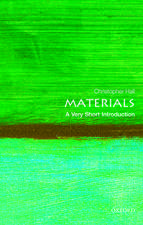Nanoparticles: Building Blocks for Nanotechnology: Nanostructure Science and Technology
Autor Vincent Rotelloen Limba Engleză Hardback – 31 dec 2003
| Toate formatele și edițiile | Preț | Express |
|---|---|---|
| Paperback (1) | 587.72 lei 6-8 săpt. | |
| Springer Us – 23 oct 2012 | 587.72 lei 6-8 săpt. | |
| Hardback (1) | 594.73 lei 6-8 săpt. | |
| Springer Us – 31 dec 2003 | 594.73 lei 6-8 săpt. |
Din seria Nanostructure Science and Technology
- 18%
 Preț: 1114.65 lei
Preț: 1114.65 lei - 18%
 Preț: 1001.02 lei
Preț: 1001.02 lei - 24%
 Preț: 834.57 lei
Preț: 834.57 lei -
 Preț: 405.66 lei
Preț: 405.66 lei -
 Preț: 405.28 lei
Preț: 405.28 lei - 18%
 Preț: 947.35 lei
Preț: 947.35 lei - 18%
 Preț: 734.27 lei
Preț: 734.27 lei - 15%
 Preț: 696.02 lei
Preț: 696.02 lei - 20%
 Preț: 585.29 lei
Preț: 585.29 lei - 20%
 Preț: 556.90 lei
Preț: 556.90 lei - 15%
 Preț: 646.62 lei
Preț: 646.62 lei - 18%
 Preț: 952.89 lei
Preț: 952.89 lei -
 Preț: 397.97 lei
Preț: 397.97 lei -
 Preț: 406.05 lei
Preț: 406.05 lei - 18%
 Preț: 967.08 lei
Preț: 967.08 lei - 18%
 Preț: 947.50 lei
Preț: 947.50 lei - 18%
 Preț: 948.29 lei
Preț: 948.29 lei - 18%
 Preț: 950.03 lei
Preț: 950.03 lei - 18%
 Preț: 951.29 lei
Preț: 951.29 lei - 18%
 Preț: 948.92 lei
Preț: 948.92 lei - 18%
 Preț: 960.13 lei
Preț: 960.13 lei - 19%
 Preț: 559.01 lei
Preț: 559.01 lei - 15%
 Preț: 694.69 lei
Preț: 694.69 lei - 15%
 Preț: 635.15 lei
Preț: 635.15 lei - 15%
 Preț: 640.06 lei
Preț: 640.06 lei - 18%
 Preț: 948.79 lei
Preț: 948.79 lei - 20%
 Preț: 564.27 lei
Preț: 564.27 lei - 20%
 Preț: 628.33 lei
Preț: 628.33 lei - 15%
 Preț: 647.59 lei
Preț: 647.59 lei - 15%
 Preț: 643.16 lei
Preț: 643.16 lei - 15%
 Preț: 643.34 lei
Preț: 643.34 lei - 18%
 Preț: 955.08 lei
Preț: 955.08 lei - 15%
 Preț: 587.72 lei
Preț: 587.72 lei - 15%
 Preț: 649.87 lei
Preț: 649.87 lei - 15%
 Preț: 646.43 lei
Preț: 646.43 lei -
 Preț: 388.72 lei
Preț: 388.72 lei - 18%
 Preț: 955.25 lei
Preț: 955.25 lei - 5%
 Preț: 716.75 lei
Preț: 716.75 lei - 18%
 Preț: 952.89 lei
Preț: 952.89 lei - 18%
 Preț: 1258.46 lei
Preț: 1258.46 lei
Preț: 594.73 lei
Preț vechi: 699.69 lei
-15% Nou
Puncte Express: 892
Preț estimativ în valută:
113.83€ • 118.39$ • 95.39£
113.83€ • 118.39$ • 95.39£
Carte tipărită la comandă
Livrare economică 14-28 martie
Preluare comenzi: 021 569.72.76
Specificații
ISBN-13: 9780306482878
ISBN-10: 0306482878
Pagini: 284
Ilustrații: X, 284 p.
Dimensiuni: 178 x 254 x 23 mm
Greutate: 0.72 kg
Ediția:2004
Editura: Springer Us
Colecția Springer
Seria Nanostructure Science and Technology
Locul publicării:New York, NY, United States
ISBN-10: 0306482878
Pagini: 284
Ilustrații: X, 284 p.
Dimensiuni: 178 x 254 x 23 mm
Greutate: 0.72 kg
Ediția:2004
Editura: Springer Us
Colecția Springer
Seria Nanostructure Science and Technology
Locul publicării:New York, NY, United States
Public țintă
ResearchCuprins
1. Synthesis and Applications of Magnetic Nanoparticles.- 1.1 Introduction.- 1.2 Applications of Magnetic Nanoparticles.- 1.3 Synthesis of Single Metal MNPs.- 1.4 Synthesis of Alloyed Metal Nanoparticles.- 1.5 Synthesis of Metal Oxide Nanoparticles.- 1.6 Self-assembled monolayers on Iron and Iron Oxide MNPs.- 1.7 Preparation of Bioconjugate MNPs.- 1.8 BlOsynthetic routes to MNPs.- 1.9 Synthesis of Diluted Magnetic Semiconductor Nanoparticles.- 1.10 Synthesis of Transition Metal Coordination Polymer Nanoparticles.- 1.11 The Limits of Nano: Single Molecule Magnets.- 1.12 Summary and Outlook.- 2. Semiconductor Nanoparticles: Synthesis, Properties, and Integration into Polymers for the Generation of Novel Composite Materials.- 2.1 Introduction.- 2.2 Nanoparticle Synthesis.- 2.3 Semiconductor Nanoparticle/Polymer Composites.- 2.4 Nanoparticle-Polymer Composites Obtained by End-Group Attachment.- 2.5 Self- and Directed-Assembly of Semiconducting Nanoparticles.- 2.6 Summary and Future Outlook.- 3. Architecture of Nanocrystal Building Blocks.- 3.1 Introduction.- 3.2 Recent Developments in the Architectural Control of Nanobuilding Blocks.- 3.3 Shape-Guiding Growth Mechanisms.- 3.4 Critical Parameters for Architecture Guiding Processes of Nanocrystals.- 3.5 Future Direction.- 4. Nanoparticle Scaffolds for Devices and Sensors.- 4.1 Introduction.- 4.2 Nanoparticles Modified with Molecular or Ionic Receptors.- 4.3 Thin Film Sensors Containing Metal Colloidal Particles.- 4.4 Organized Nanoparticle Assemblies.- 4.5 Conclusions and Outlook.- 5. Nanoparticles in Catalysis.- 5.1 Introduction.- 5.2 Fundamental Issues.- 5.3 Challenges and Opportunities.- 5.4 Fabrication of Nanoparticles as Catalysts.- 5.5 Traditional Approaches.- 5.6 Surface-Capping Approaches.- 5.7 Surpported Nanoparticle catalysts.- 5.8 Assembled Nanoparticle Catalysts.- 5.9 The Nanoparticle Assembly.- 5.10 The Catalytic Activation.- 5.11 Conclusions and Prospectus.- 6. Adventures with Smart Chemical Sensing: Electrooptically Responsive Photonic Crystals.- 6.1 Introduction.- 6.2 Diffraction from CCA Photonic Crystals.- 6.3 CCA Optical Switching and Optical Limiting.- 6.4 Polymerized Colloidal Array Switching and Optical Limiting.- 6.5 PCCA Photonic Crystal Chemical Sensing Materials.- 6.6 Conclusions.- 7. Plasmonic Nanomaterials: Enhanced Optical Properties from Metal Nanoparticles and Their Ensembles.- 7.1 Introduction.- 7.2 Surface Plasmons in Spherical Metal Nanoparticles.- 7.3 Surface Plasmons: Theoretical Considerations.- 7.4 Surface Plasmons and the Material function.- 7.5 Metal Nanoparticle Ensembles.- 7.6 Conclusion.- 8. Nanoparticle Polymer Ensembles.- 8.1 Introduction.- 8.2 Assembly of Polymer-Nanoparticle Composite Materials.- 8.3 Nanoparticle Building Blocks and Polymer Scaffolds.- 8.4 Polymer-Nanoparticle Assemblies for Catalyic Applications.- 8.5 Fabrication of Polymer-Mediated Organized Nanoparticle Assemblies.- 8.6 Organized Polymer-Nanoparticle Assemblies on Surfaces.- 8.7 Dendrimers in Catalytic and Assembly.- 8.8 Conclusion.- 9. Electrostatic Assembly of Nanoparticles.- 9.1 Introduction.- 9.2 Electrostatic Nanoparticle Assembly in Solution.- 9.3 Electrostatically Driven Nanoparticle Assembly in Thin Films.- 10. Biological and Biomimetic Applications of Nanoparticles.- 10.1 Introduction.- 10.2 Colloidal Gold Bioconjugates.- 10.3 Low and High Nuclearity Metal Clusters Conjugates.- 10.4 Biological Applications of Semiconductors Quantum Dots.- 10.5 DNA and Nanoparticles.- 10.6 DNA Recognition.- 10.7 DNA-Nanoparticle-Based Devices.- 10.8 Biomimetic Applications: Mimicry of Carbohydrate-Protein and Carbohydrate-Carbohydrate Interactions.- 10.9 Mimicry of Polyvalency and Cooperativity.- 10.10 Nanomaterials as Delivery Systems.- 10.11 Conclusion.- 283.










